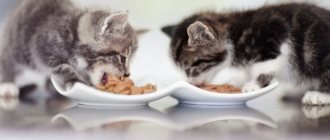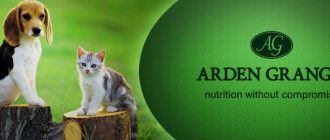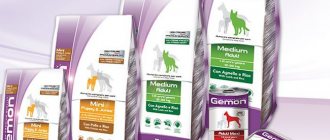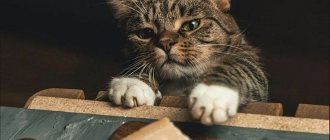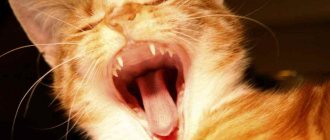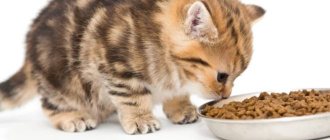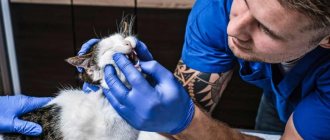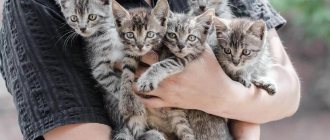September 7, 2018
A balanced diet is especially important for kittens; it is at this age that the animal actively grows and develops. High-quality dry food is just such a product, which means it may well become the first “adult” diet for babies, which is introduced even before the end of breastfeeding. Let's figure out at what age kittens are given dry food.
The need for complementary feeding for kittens up to 1 month
The benefit of breast milk lies not only in its fortified composition, but also in the transfer of protective antibodies. Together with him, the baby receives passive immunity, protecting against infections until the first vaccinations.
If natural feeding is not possible, then artificial milk formulas are introduced into the diet. You can buy them at a pet store or veterinary pharmacy.
NOTE!
The use of goat's and cow's milk is only permissible on a short-term basis. Their prolonged use causes intestinal problems and contributes to the development of vitamin deficiency.
When do you start feeding kittens?
Breastfeeding continues up to 2.5-3 months, that is, until moving to a new family. Before this important event, the little “mustaches” have their first milk teeth - the main landmark for starting complementary feeding.
Optimal age
The incisors are the first to grow (at 3-4 weeks of life), and after them (at 4-8 weeks) the fangs erupt. Premolars, necessary for chewing, appear only at 2.5-3 months, so at first babies are fed soft food.
Closer to the 4th week of life, the cubs begin to show interest in their mother's feeder, as breast milk becomes insufficient. Thanks to this, problems with introducing new products usually do not arise.
Differences by breed
When feeding, it is recommended to follow the general rules. The existing differences are minimal. They depend on size, rate of maturation, heat transfer characteristics and tendency to be overweight. Based on these characteristics, the following representatives can be distinguished:
- "Scots" and "British"
. Both breeds gain weight quickly. They should be fed low carbohydrate, high protein meals.
- Maine Coons
. 2-month-old “fluffies” calmly eat 225-230 g of food per day, although in most breeds only adult animals can handle this amount. The rate of maturation also differs, so Maine Coons are fed only at 8 weeks of life.
- Sphinxes
. These cats are voracious, but, unlike the “British” ones, they are much less prone to being overweight. Most of what you eat serves as fuel to warm your body. In the first 2 months of life, they are fed frequent but small portions up to 6-8 times a day.
Be sure to consult with the breeder or veterinarian about all possible nuances regarding the chosen breed. This will help avoid allergic reactions and other complications.
When does weaning occur?
The largest amount of beneficial substances and antibodies is contained in colostrum. Kittens feed on it for about 3-5 days after birth, and only after that on breast milk. The duration of breastfeeding depends on the following factors:
- Individual characteristics of the body
. The mother can abandon her cubs immediately after birth or, conversely, allow them to come near her for up to six months.
- Presence of diseases
. Complications after childbirth, helminthiases and other disorders significantly reduce lactation, preventing prolonged breastfeeding.
- Number of cubs
. The fewer applicants for the breast, the longer the milk lasts.
- Diet quality
. The more fluids you drink per day, the better your lactation.
Weaning begins with the introduction of complementary foods. After adding it, the number of breastfeedings is gradually reduced from 6-12 to 3-4 times a day. A complete refusal of mother's milk occurs with addiction to independent consumption of adult food.
Recommended Products
With the appearance of teeth, the first solid food is added to the diet in addition to milk. The list of recommended products depends on the type of feeding chosen.
Industrial feed
The safest and most convenient option is ready-made food intended for kittens, pregnant and lactating cats. They have many advantages:
- save time on cooking;
- have a balanced composition;
- do not require independent calculation of the daily requirement, everything is already indicated on the packaging;
- strengthen the jaw muscles and prevent the development of tartar.
At first, you should feed your pet with heated, wet canned food in the form of a pate, a little later with meat pieces in gravy, and at the very end of complementary feeding with dry granules.
IMPORTANT!
Be sure to check with the breeder exactly what he fed the kittens. It is recommended to stick to this brand for up to a year.
Natural nutrition
Unlike industrial feeds, natural food requires daily preparation and the mandatory inclusion of vitamin and mineral supplements. Stale or improperly prepared food can lead to poisoning and parasite infestation.
When choosing “natural” foods, use liquid rice and semolina porridges, light meat broths, natural low-fat fermented milk products, pureed vegetables and minced meat. All food is pre-boiled and served in crushed form.
Forbidden food
When using industrial feed, it is enough not to buy economy-class products. With a “straight woman” everything is more complicated. Here is a whole list of prohibited products:
- legumes and white cabbage;
- corn, pearl barley and millet;
- garlic, onion and sorrel;
- bones and river fish;
- pork and lard;
- raw egg whites and chicken skin;
- potatoes and mushrooms;
- grapes and raisins;
- any products from the human table (sweets, pickles, smoked foods).
The ban also applies to whole milk. As animals grow older, they develop lactose intolerance, which can lead to abdominal pain, bloating, loose stools and nausea.
Natural menu
Natural nutrition is considered the most balanced.
Products for a natural diet:
Lean meats. Veal, lamb, rabbit, turkey, and chicken are suitable for feeding kittens. The meat is given boiled, raw, in small portions, after having been doused with boiling water. Meat products should make up 80-90% of the total diet.
Porridge. Cereals (rice, buckwheat, oatmeal, wheat) can be cooked in vegetable, meat, or fish broth. They should be well boiled. You can add minced meat, meat, vegetables, and herbs to the porridge.
Dairy products. Kittens can be given milk, kefir, fermented baked milk, skim milk, calcined cottage cheese, natural yoghurts without dyes.
Ocean fish, sea fish of low-fat varieties. It is given to a kitten no more than twice a week and only in boiled, stewed, baked form, after removing the seeds.
Offal. They are introduced into the diet of kittens starting from 5-6 months. Served raw or boiled. Kittens can be fed chicken hearts, stomachs, and calf liver.
Eggs. Once a week, offer the kitten one boiled yolk. Give raw eggs if you are confident in their quality and freshness.
Greens, vegetables, fruits. They contain a large amount of vitamins, minerals, and beneficial organic compounds. Vegetables are given boiled, stewed, baked or raw. They are mixed with minced meat. For better digestibility, season the vegetables with a small amount of vegetable oil.
Food should always be fresh, at room temperature. After each feeding, wash bowls well with running water. Calculate portions correctly and adhere to the frequency of feedings and daily routine.
Feeding schedule
When creating a diet, it is important to pay attention to the feeding schedule. The ease of assimilation of what you eat and the saturation of the body depend on the correctness of its construction.
How to give for the first time
Babies are fed simultaneously with drinking milk, that is, every 3-4 hours. Per 100 g of weight there should be 50-55 ml of liquid food.
Remember that all food should be soft and warm. Harder foods are introduced a little later, when the pet learns to chew on its own.
Increasing the size and frequency of complementary foods
Not all animals have a feeling of satiety. Providing complementary foods at every squeak is fraught with obesity, urolithiasis, pathologies of the musculoskeletal system and other diseases. For this reason, it is important to consider portion sizes and meal frequency when creating a schedule. Both depend on age:
- From 1 to 2 months the pet is fed 7 times a day. The daily serving size should not exceed 120 g.
- From 2 to 3 months, the frequency is reduced to 6 times a day, and the daily portion size is increased to 150 g.
The exact size of the daily portion is calculated using a special formula with a coefficient taking into account the age and activity of the animal. You can also use an easier option and determine 5% of body weight. This formula gives the average value.
Smooth transition to solid food, portion size
At first, the baby is fed milk porridge, and after 5-6 days - porridge with minced meat. Gradually the amount of meat is increased, and at 2 months it is given in its pure form.
They switch to solid food with the appearance of all the milk teeth, when the pet not only laps up the broth and slimy porridge, but chews minced meat and small pieces of chicken without any problems. Before serving, the meat must be frozen and boiled.
For three-month-old “mustaches,” the number of meals is reduced to 4 times, and the daily intake is calculated based on weight. For every kilogram there should be 200 g of food. At the same time, the volume of fermented milk products is reduced, and when cooking porridge, either water or meat broth is used.
When calculating portions, be sure to focus on your pet’s weight. If it is below normal, feel free to increase the amount of food, and if it is more, reduce it. For 8-month-old animals, the diet should be as close as possible to that of an adult.
Weaners
When new owners acquire a kitten, they must ask what food the previous owners used, and do not change the diet for the first few days. Then you need to make a choice of the product that the baby will eat. The transition from one food to another should be carried out smoothly, over 1–2 weeks. The percentage of the old feed gradually decreases and the share of the new feed increases. If the kitten was fed wet formula or natural food, and the owner wants to switch to a dehydrated diet, there may be a need to accustom him to a new food through the soaking stage.
At three months of age, a teenager's teeth begin to change. If the owners of the animal intend to engage in breeding and attend exhibitions, they must by this time decide on the final choice of food. Four-month-olds can eat junior food or food intended for adult cats.
Introducing dry food into a kitten's diet
Unlike pates and meat pieces, dry granules require the presence of teeth. This is exactly what you need to focus on when choosing the right age.
Suitable age
If you choose to feed with industrial food, then there are two options. It is easiest to feed with meat pates and spiders. They are introduced immediately after the incisors erupt.
In addition to their soft consistency, they have a pleasant smell and taste, so animals get used to them very quickly. In this case, dry granules are added when all baby teeth appear, that is, at 2.5-3 months.
Despite the benefits, not all owners can afford to buy more expensive wet food. Most choose the second option - feeding dry granules with the addition of pates in the form of treats. In this case, the introduction is also carried out after the incisors have erupted. The problem is that babies do not yet know how to chew and cannot crack hard pieces without assistance.
Do I need to soak it?
It all depends on the age of the pet. If he only has baby incisors, then he will have to get help. Soaking the granules in warm boiled water will eliminate the need for thorough chewing.
NOTE!
Use only fresh water. Adding milk or broth will lead to a mixed diet and problems with the gastrointestinal tract.
When can you start feeding only dry food?
Focus on the presence of a nursing cat. If she has enough milk and does not drive away the cubs, wait for a natural interruption of breastfeeding. If the situation is the opposite or you have taken your small pet to another home, then feel free to switch to full feeding with dry food.
Natural nutrition
During the period of teeth change, the baby’s body needs solid food, mainly protein and, without fail, various dairy products. If your pet cannot tolerate whole cow's milk, you can replace it with fermented milk products. The baby’s “food basket” should contain lean meat (poultry, beef, rabbit, etc.), eggs, vegetables, and cereals. The meat part should make up more than 50% of the diet, vegetables and cereals - less than 50% of the daily portion.
It is unacceptable to feed a kitten food from your table. Human food can cause digestive problems in a baby.
A kitten definitely needs meat. Meat products can be given both boiled and raw. It should be lean meat: beef, rabbit, lamb, chicken or turkey fillet. It is better to avoid pork due to its fat content and the risk of helminth infection. Starting from the age of three months, kittens can be given raw meat, but it must first be well frozen. You don’t have to grind the products into minced meat, but simply cut them into pieces.
Dairy products are the main suppliers of calcium; during the period of active growth of the skeletal system and teeth change, their presence in the diet is of particular importance. It is better to choose low-fat products. If your baby does not digest milk well, replace it with fermented milk products (yogurt, kefir, fermented baked milk, etc.). Eggnog made from cottage cheese, milk and egg yolk is very useful for kittens. It's delicious and very nutritious. It is permissible to occasionally offer your small pet small portions of low-fat sour cream and cheese.
Vegetables are very useful, primarily as a source of vitamins and fiber, but pets do not always like the taste of them. You can get out of this situation by adding pureed vegetables (pumpkin, cabbage, carrots) to the main dish, or cooking porridge in vegetable broth.
Egg yolk can be given either boiled or raw. This is a very nutritious product, the most valuable part of a chicken egg.
Low-fat fish. It is better to choose sea fish, as it is less bony and does not carry the risk of infection with worms. But it is not recommended to offer fish too often; give it no more than once a week.
Cereals in the form of various porridges - in milk, vegetable or meat broths. The most suitable ones are semolina and rice; it is better to avoid legumes and rolled oats. Legumes are difficult to digest and cause bloating, and rolled oats are overly rich in carbohydrates.
Fresh green grass is needed to cleanse the gastrointestinal tract. You can grow it yourself or buy oat and wheat sprouts in a store or veterinary pharmacy.
Vegetable oil, which has a choleretic and mild laxative effect, can be added to the main dish in small quantities to improve the digestion process.
What to exclude from a kitten's diet?
There are a number of products whose presence in the diet of small pets is either completely unacceptable or acceptable in very limited quantities.
Unacceptable products:
- Any fatty food (meat, fish, lard, etc.).
- Bones. Meat products in a baby’s diet should be exclusively in the form of fillets. Eating bones can lead to very serious health problems.
- Whole cow's milk. It is quite fatty and often simply is not absorbed by the kittens’ body, causing intestinal upset.
- Salty, smoked, spicy foods, such as sausage.
- Canned food intended for human consumption.
- Everything is fried.
- Tomatoes and eggplants.
- Corn grits.
- Sweets.
Products allowed in limited quantities:
- Hercules and legumes.
- River fish.
- Potato.
There are foods that should not be given under certain conditions. So, in case of diarrhea, it is necessary to exclude fermented milk products from the diet, and in case of constipation, solid foods rich in carbohydrates and starch.
What specific products and in what volume will be present in your little pet’s diet is up to you, but there are standard recommendations for creating a menu for a 3-4 month old kitten.
| Product name | Quantity | Frequency of use |
| Meat (beef) | 40-80 g | every day |
| Milk. Fermented milk products | 100g | every day |
| Vegetable oil | half a teaspoon | in one day |
| Chicken (minced or pieces) | 40-120g | in one day |
| Puree vegetables | 20-30g | in one day |
| Egg yolk | 1 PC | once a week |
| Cereals (porridge) | 100g | in 1 week |
| Fish (sea) | 100g | once a week |
| Liver | 50g | in 1 week |
The table shows average values. The amount of food can be changed in one direction or another by 5-10%, depending on the age of the kitten, its weight, and activity.
Drinking regime
To digest solid food, more liquid is required, so with the introduction of complementary foods it is necessary to pay special attention to the drinking regime. Change the water in the bowl every day, and in the summer - 2 times a day. Otherwise, bacteria and other harmful microorganisms will accumulate in it.
Remember that animals can only be given bottled water from the store or filtered water. Tap water contains metals, salts and other dangerous deposits that can harm the body.
How to teach a puppy to eat from a bowl
The procedure is quite simple. Often, puppies, attracted by the tasty smell, eat from the bowl themselves. If this does not happen, you can lightly poke your pet’s nose into the treat - he will be forced to lick his nose and lips, feel the taste of the food and start eating.
On a note! When feeding natural food, you need to make sure that the cup (especially if a metal one is used) is not hot - if it gets burned, the puppy will retain a dislike for the bowl for the rest of its life.
At this stage, it is important not to scare your pet. Otherwise, he will simply be afraid to eat from a cup, and this will cause a lot of problems for the owner
You can't yawn in a big family
Understanding all the intricacies of feeding a puppy is not that difficult. Therefore, nothing will prevent you from providing your pet with tasty and healthy food from the first weeks of life.

